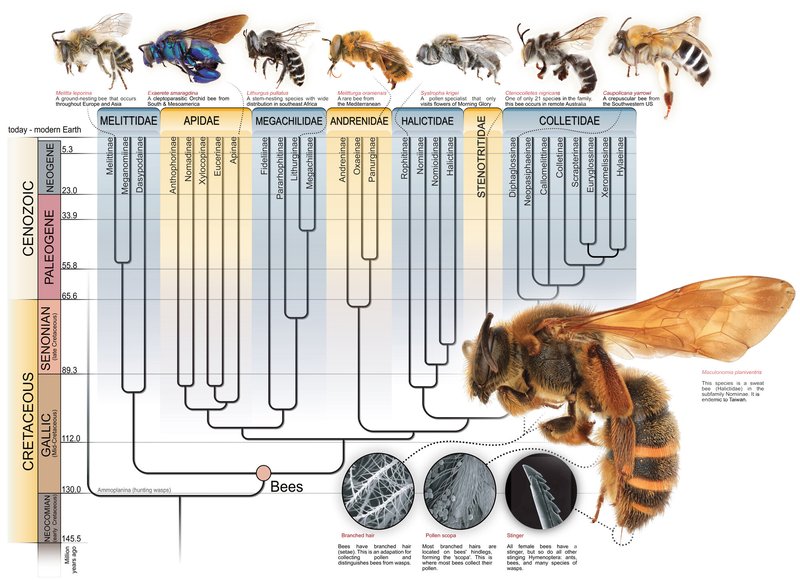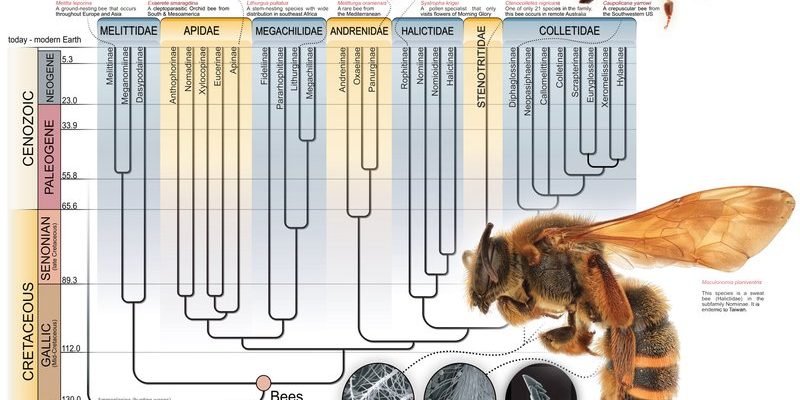
To understand the evolution of honey bees, we should start with their ancestors. Much like how our own story begins with evolution, the tale of honey bees started millions of years ago, well before humans became a twinkle in the universe’s eye. You might be surprised to learn that honey bees belong to a family called Apidae, which includes over 20,000 different species of bees! Unlike their solitary cousins, honey bees prefer to work together, forming complex colonies. Let’s explore this intriguing journey through time and the role honey bees play in our world.
The Origins of Bees: A Journey Through Time
Honey bees trace their roots back to the Cretaceous period, around 100 million years ago. During this time, the Earth was a very different place. Flowering plants were just beginning to bloom, creating a perfect environment for bees to thrive. Early ancestors of modern bees, like the *Melittidae* family, were already buzzing around, but they hadn’t yet developed the social structures we recognize today.
Fast forward to about 60 million years ago, and bees started to evolve into more complex forms. This was a time of great floral diversification. As plants evolved, so did the bees that pollinated them. They began to adapt to different environments, developing specialized features—such as longer tongues to reach deeper flowers—to access nectar and pollen more efficiently. Can you imagine how competitive it must have been among these creatures, each vying for a sweet reward?
Eventually, about 15 million years ago, the honey bee we know today emerged. This species, known as *Apis mellifera*, developed a unique ability to store honey, making them a vital part of the ecosystem. They created intricate hives and worked together in colonies, showcasing amazing teamwork. It’s almost like they formed little societies with their own set of rules, roles, and responsibilities!
The Social Structure of Honey Bees
One of the most remarkable aspects of honey bees is their incredibly organized social structure. Each colony consists of three main types of bees: the queen, workers, and drones. The queen’s job is to lay eggs—thousands of them! Worker bees, on the other hand, take care of the hive, gather nectar, and protect their home. Drones are the male bees, whose sole purpose is to mate with a queen from another hive.
You might be wondering why these roles are so important. Well, the survival of the colony depends on this well-defined system. Each type of bee plays a crucial role. For instance, without worker bees, the hive wouldn’t be able to gather food or maintain the structure of the hive. Imagine a tiny city where everyone has a job, and each job is vital to its success!
Interestingly, honey bees are also known for their communication skills. They perform a dance known as the “waggle dance” to inform their fellow bees about the location of food sources. This fascinating behavior is a testament to their intelligence. It’s not just about buzzing around; they’re actually sharing valuable information—just like we do when we share tips about local coffee shops!
The Importance of Honey Bees in Ecosystems
Honey bees are often hailed as crucial to our ecosystems. They play a significant role in pollinating many fruits, vegetables, and nuts that we rely on for food. Without pollinators like honey bees, our diets would look very different. Think about all those delicious berries, almonds, and apples—many of them depend on these bees for their growth!
Additionally, honey bees contribute to the biodiversity of plants. By facilitating pollination, they help to ensure that many plant species can reproduce successfully. The more diverse our plant life, the healthier our ecosystems are. And guess what? Healthy ecosystems provide numerous benefits, from cleaner air and water to thriving wildlife.
Let’s not forget the economic impact of honey bees, either. They support agriculture and contribute billions of dollars to the economy each year. Farmers often hire beekeepers to place hives in their fields to enhance crop yields. It’s a win-win situation: farmers get better yields, and bees get a steady supply of food.
Challenges Facing Honey Bees Today
Despite their importance, honey bees are facing many challenges today. One major threat is the use of pesticides, which can harm bees and disrupt their ability to gather food. Habitat loss is another critical issue; as urban areas expand, bees lose places to live and forage. It’s quite alarming when you think about how much they rely on a healthy environment to thrive.
Diseases and parasites, such as the Varroa mite, also pose significant threats to honey bee colonies. These tiny pests attach to bees and feed on their blood, weakening them and potentially leading to colony collapse. It’s a bit like a horror movie, where the heroes find themselves in a fight for survival against unseen enemies.
So, what can we do to help honey bees? You might be surprised at how simple it can be. Planting flowers, reducing pesticide use, and supporting local beekeepers are just a few ways to make a difference. Every small action can contribute to the well-being of these essential pollinators.
The Cultural Significance of Honey Bees
Beyond their ecological impact, honey bees have also woven themselves into human culture and history. In ancient Egypt, for instance, honey was considered a sacred substance and was used in religious rituals, as well as for medicinal purposes. The Egyptians even placed honey in tombs, believing it would accompany the deceased into the afterlife!
In many cultures, honey symbolizes wealth, prosperity, and good health. It’s often used in rituals and celebrations, from weddings to religious ceremonies. The phrase “as sweet as honey” reflects our admiration for this natural product, which has been cherished throughout time.
Even in modern art and literature, honey bees appear as symbols of community, hard work, and cooperation. They remind us of the beauty of teamwork and the importance of supporting one another. It’s fascinating how these tiny insects have inspired human creativity and values for centuries.
The evolution and history of honey bees reveal much about their significance in our lives and the environment. As we’ve explored, these fascinating creatures have not only adapted over millions of years but also developed complex social structures, communication methods, and cultural importance. They are more than just insects; they are vital to our ecosystems and the food we eat.
However, the challenges facing honey bees today remind us of our responsibility to protect them. By making conscious choices and advocating for their well-being, we can ensure that future generations continue to enjoy the sweetness of honey and the beauty of thriving ecosystems.
So, the next time you see a honey bee buzzing around, take a moment to appreciate its journey—because it’s a tiny wonder with a big story!

